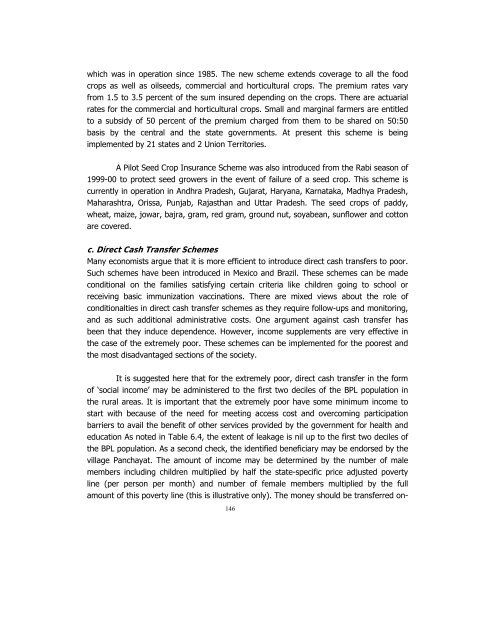POVERTY REDUCTION STRATEGY TN
You also want an ePaper? Increase the reach of your titles
YUMPU automatically turns print PDFs into web optimized ePapers that Google loves.
which was in operation since 1985. The new scheme extends coverage to all the food<br />
crops as well as oilseeds, commercial and horticultural crops. The premium rates vary<br />
from 1.5 to 3.5 percent of the sum insured depending on the crops. There are actuarial<br />
rates for the commercial and horticultural crops. Small and marginal farmers are entitled<br />
to a subsidy of 50 percent of the premium charged from them to be shared on 50:50<br />
basis by the central and the state governments. At present this scheme is being<br />
implemented by 21 states and 2 Union Territories.<br />
A Pilot Seed Crop Insurance Scheme was also introduced from the Rabi season of<br />
1999-00 to protect seed growers in the event of failure of a seed crop. This scheme is<br />
currently in operation in Andhra Pradesh, Gujarat, Haryana, Karnataka, Madhya Pradesh,<br />
Maharashtra, Orissa, Punjab, Rajasthan and Uttar Pradesh. The seed crops of paddy,<br />
wheat, maize, jowar, bajra, gram, red gram, ground nut, soyabean, sunflower and cotton<br />
are covered.<br />
c. Direct Cash Transfer Schemes<br />
Many economists argue that it is more efficient to introduce direct cash transfers to poor.<br />
Such schemes have been introduced in Mexico and Brazil. These schemes can be made<br />
conditional on the families satisfying certain criteria like children going to school or<br />
receiving basic immunization vaccinations. There are mixed views about the role of<br />
conditionalties in direct cash transfer schemes as they require follow-ups and monitoring,<br />
and as such additional administrative costs. One argument against cash transfer has<br />
been that they induce dependence. However, income supplements are very effective in<br />
the case of the extremely poor. These schemes can be implemented for the poorest and<br />
the most disadvantaged sections of the society.<br />
It is suggested here that for the extremely poor, direct cash transfer in the form<br />
of ‘social income’ may be administered to the first two deciles of the BPL population in<br />
the rural areas. It is important that the extremely poor have some minimum income to<br />
start with because of the need for meeting access cost and overcoming participation<br />
barriers to avail the benefit of other services provided by the government for health and<br />
education As noted in Table 6.4, the extent of leakage is nil up to the first two deciles of<br />
the BPL population. As a second check, the identified beneficiary may be endorsed by the<br />
village Panchayat. The amount of income may be determined by the number of male<br />
members including children multiplied by half the state-specific price adjusted poverty<br />
line (per person per month) and number of female members multiplied by the full<br />
amount of this poverty line (this is illustrative only). The money should be transferred on-<br />
146

















